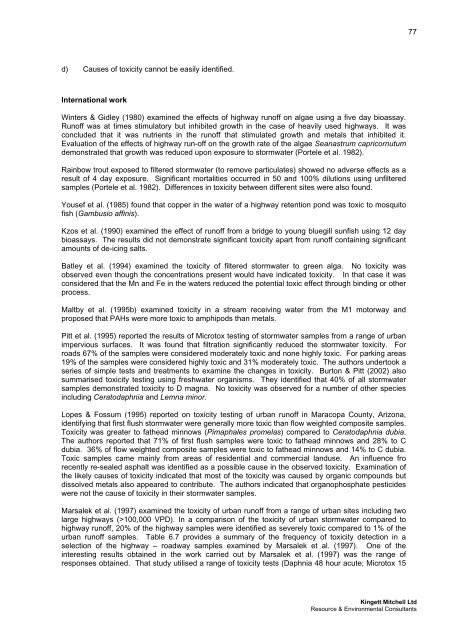The Effects of Road Transport on Freshwater and Marine Ecosystems
The Effects of Road Transport on Freshwater and Marine Ecosystems
The Effects of Road Transport on Freshwater and Marine Ecosystems
You also want an ePaper? Increase the reach of your titles
YUMPU automatically turns print PDFs into web optimized ePapers that Google loves.
77<br />
d) Causes <str<strong>on</strong>g>of</str<strong>on</strong>g> toxicity cannot be easily identified.<br />
Internati<strong>on</strong>al work<br />
Winters & Gidley (1980) examined the effects <str<strong>on</strong>g>of</str<strong>on</strong>g> highway run<str<strong>on</strong>g>of</str<strong>on</strong>g>f <strong>on</strong> algae using a five day bioassay.<br />
Run<str<strong>on</strong>g>of</str<strong>on</strong>g>f was at times stimulatory but inhibited growth in the case <str<strong>on</strong>g>of</str<strong>on</strong>g> heavily used highways. It was<br />
c<strong>on</strong>cluded that it was nutrients in the run<str<strong>on</strong>g>of</str<strong>on</strong>g>f that stimulated growth <strong>and</strong> metals that inhibited it.<br />
Evaluati<strong>on</strong> <str<strong>on</strong>g>of</str<strong>on</strong>g> the effects <str<strong>on</strong>g>of</str<strong>on</strong>g> highway run-<str<strong>on</strong>g>of</str<strong>on</strong>g>f <strong>on</strong> the growth rate <str<strong>on</strong>g>of</str<strong>on</strong>g> the algae Seanastrum capricornutum<br />
dem<strong>on</strong>strated that growth was reduced up<strong>on</strong> exposure to stormwater (Portele et al. 1982).<br />
Rainbow trout exposed to filtered stormwater (to remove particulates) showed no adverse effects as a<br />
result <str<strong>on</strong>g>of</str<strong>on</strong>g> 4 day exposure. Significant mortalities occurred in 50 <strong>and</strong> 100% diluti<strong>on</strong>s using unfiltered<br />
samples (Portele et al. 1982). Differences in toxicity between different sites were also found.<br />
Yousef et al. (1985) found that copper in the water <str<strong>on</strong>g>of</str<strong>on</strong>g> a highway retenti<strong>on</strong> p<strong>on</strong>d was toxic to mosquito<br />
fish (Gambusio affinis).<br />
Kzos et al. (1990) examined the effect <str<strong>on</strong>g>of</str<strong>on</strong>g> run<str<strong>on</strong>g>of</str<strong>on</strong>g>f from a bridge to young bluegill sunfish using 12 day<br />
bioassays. <str<strong>on</strong>g>The</str<strong>on</strong>g> results did not dem<strong>on</strong>strate significant toxicity apart from run<str<strong>on</strong>g>of</str<strong>on</strong>g>f c<strong>on</strong>taining significant<br />
amounts <str<strong>on</strong>g>of</str<strong>on</strong>g> de-icing salts.<br />
Batley et al. (1994) examined the toxicity <str<strong>on</strong>g>of</str<strong>on</strong>g> filtered stormwater to green alga. No toxicity was<br />
observed even though the c<strong>on</strong>centrati<strong>on</strong>s present would have indicated toxicity. In that case it was<br />
c<strong>on</strong>sidered that the Mn <strong>and</strong> Fe in the waters reduced the potential toxic effect through binding or other<br />
process.<br />
Maltby et al. (1995b) examined toxicity in a stream receiving water from the M1 motorway <strong>and</strong><br />
proposed that PAHs were more toxic to amphipods than metals.<br />
Pitt et al. (1995) reported the results <str<strong>on</strong>g>of</str<strong>on</strong>g> Microtox testing <str<strong>on</strong>g>of</str<strong>on</strong>g> stormwater samples from a range <str<strong>on</strong>g>of</str<strong>on</strong>g> urban<br />
impervious surfaces. It was found that filtrati<strong>on</strong> significantly reduced the stormwater toxicity. For<br />
roads 67% <str<strong>on</strong>g>of</str<strong>on</strong>g> the samples were c<strong>on</strong>sidered moderately toxic <strong>and</strong> n<strong>on</strong>e highly toxic. For parking areas<br />
19% <str<strong>on</strong>g>of</str<strong>on</strong>g> the samples were c<strong>on</strong>sidered highly toxic <strong>and</strong> 31% moderately toxic. <str<strong>on</strong>g>The</str<strong>on</strong>g> authors undertook a<br />
series <str<strong>on</strong>g>of</str<strong>on</strong>g> simple tests <strong>and</strong> treatments to examine the changes in toxicity. Burt<strong>on</strong> & Pitt (2002) also<br />
summarised toxicity testing using freshwater organisms. <str<strong>on</strong>g>The</str<strong>on</strong>g>y identified that 40% <str<strong>on</strong>g>of</str<strong>on</strong>g> all stormwater<br />
samples dem<strong>on</strong>strated toxicity to D magna. No toxicity was observed for a number <str<strong>on</strong>g>of</str<strong>on</strong>g> other species<br />
including Ceratodaphnia <strong>and</strong> Lemna minor.<br />
Lopes & Fossum (1995) reported <strong>on</strong> toxicity testing <str<strong>on</strong>g>of</str<strong>on</strong>g> urban run<str<strong>on</strong>g>of</str<strong>on</strong>g>f in Maracopa County, Ariz<strong>on</strong>a,<br />
identifying that first flush stormwater were generally more toxic than flow weighted composite samples.<br />
Toxicity was greater to fathead minnows (Pimaphales promelas) compared to Ceratodaphnia dubia.<br />
<str<strong>on</strong>g>The</str<strong>on</strong>g> authors reported that 71% <str<strong>on</strong>g>of</str<strong>on</strong>g> first flush samples were toxic to fathead minnows <strong>and</strong> 28% to C<br />
dubia. 36% <str<strong>on</strong>g>of</str<strong>on</strong>g> flow weighted composite samples were toxic to fathead minnows <strong>and</strong> 14% to C dubia.<br />
Toxic samples came mainly from areas <str<strong>on</strong>g>of</str<strong>on</strong>g> residential <strong>and</strong> commercial l<strong>and</strong>use. An influence fro<br />
recently re-sealed asphalt was identified as a possible cause in the observed toxicity. Examinati<strong>on</strong> <str<strong>on</strong>g>of</str<strong>on</strong>g><br />
the likely causes <str<strong>on</strong>g>of</str<strong>on</strong>g> toxicity indicated that most <str<strong>on</strong>g>of</str<strong>on</strong>g> the toxicity was caused by organic compounds but<br />
dissolved metals also appeared to c<strong>on</strong>tribute. <str<strong>on</strong>g>The</str<strong>on</strong>g> authors indicated that organophosphate pesticides<br />
were not the cause <str<strong>on</strong>g>of</str<strong>on</strong>g> toxicity in their stormwater samples.<br />
Marsalek et al. (1997) examined the toxicity <str<strong>on</strong>g>of</str<strong>on</strong>g> urban run<str<strong>on</strong>g>of</str<strong>on</strong>g>f from a range <str<strong>on</strong>g>of</str<strong>on</strong>g> urban sites including two<br />
large highways (>100,000 VPD). In a comparis<strong>on</strong> <str<strong>on</strong>g>of</str<strong>on</strong>g> the toxicity <str<strong>on</strong>g>of</str<strong>on</strong>g> urban stormwater compared to<br />
highway run<str<strong>on</strong>g>of</str<strong>on</strong>g>f, 20% <str<strong>on</strong>g>of</str<strong>on</strong>g> the highway samples were identified as severely toxic compared to 1% <str<strong>on</strong>g>of</str<strong>on</strong>g> the<br />
urban run<str<strong>on</strong>g>of</str<strong>on</strong>g>f samples. Table 6.7 provides a summary <str<strong>on</strong>g>of</str<strong>on</strong>g> the frequency <str<strong>on</strong>g>of</str<strong>on</strong>g> toxicity detecti<strong>on</strong> in a<br />
selecti<strong>on</strong> <str<strong>on</strong>g>of</str<strong>on</strong>g> the highway – roadway samples examined by Marsalek et al. (1997). One <str<strong>on</strong>g>of</str<strong>on</strong>g> the<br />
interesting results obtained in the work carried out by Marsalek et al. (1997) was the range <str<strong>on</strong>g>of</str<strong>on</strong>g><br />
resp<strong>on</strong>ses obtained. That study utilised a range <str<strong>on</strong>g>of</str<strong>on</strong>g> toxicity tests (Daphnia 48 hour acute; Microtox 15<br />
Kingett Mitchell Ltd<br />
Resource & Envir<strong>on</strong>mental C<strong>on</strong>sultants
















